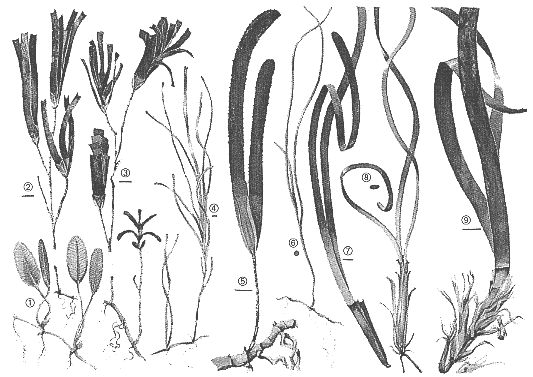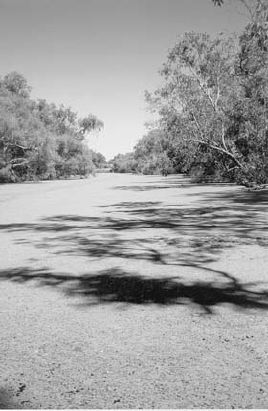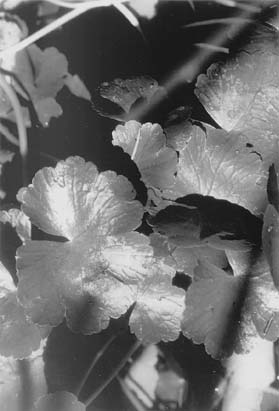Albany Waterways Resource Book:
Waterway lifeAquatic plants
Plants (also called by their Latin name 'flora') that are found in waterways include microalgae, macroalgae and seagrasses. As well as being pretty to look at, which is an important part of well-being for humans, flora are vital to life in an estuary. They provide food, shelter and breeding sites for fish, reptiles, frogs, birds and mammals. They absorb nutrients, stop the sediments from being washed away, and colour the water (gilvins and tannins). They also keep oxygen and nutrient levels balanced.
Aquatic flora are extremely important in waterways ecosystems because they are the basis of the food web. Furthermore, fringing vegetation can reduce bank erosion caused by speedboats and provide shelter and breeding sites. Aquatic flora is vulnerable and can be easily degraded or destroyed by clearing, dredging and other human activities.
Types of aquatic plants
Aquatic plants can be divided into two categories: algae and seagrasses. Algae can be further divided into macroscopic or microscopic algae.
Microscopic algae
Microscopic algae are also called `phytoplankton' (from Greek, meaning `wandering plant'). Microscopic algae can only be seen under a microscope. These tiny plants float or swim in the water. Some are able to move closer to the surface - so they can photosynthesise - then drift down to the bottom to use nutrients which are released from the water near the sediments. These plants take the nutrients they need for growth from the water. Algae are always present in the water in low numbers. When conditions such as salinity, temperature and nutrient levels are right, they can grow extremely fast. This is called an algal 'bloom'. Blooms can discolour the water, making the algae much more noticeable.
Macroscopic algae
Macroscopic algae are easily seen and are very similar to the large seaweeds that are often washed up on beaches. Their colours range from red-brown through various greens. They may float in the water or be attached to a substrate - such as rocks - or jetty pylons. It is sometimes difficult to distinguish the various types washed up on the foreshore as they become dried out and start to decompose. Different algae appear in different forms in different estuaries around the South-West. For example, Cladophora appears in the Peel-Harvey Estuary as small, cotton wool-like, brown balls which form a carpet on the bottom. In the Swan River the same macroalgae appears in small clumps on jetty piles and ramps.
Table 6-1: Common types of macroalgae found in waterways
| Scientific name | Description |
| Cladophora | 'Goat weed' grows as small, cotton wool-like, brown balls forming a carpet on the bottom. |
| Chaetomorpha | 'Rope weed' is green and forms a tangle of `ropes', about 15 cm round and of various lengths, as it is rolled around by wind waves. |
| Enteromorpha | This plant - like a hollow green straw - is found in two forms: one thick and one thin. |
| Ulva | 'Sea lettuce' is green and looks like lettuce leaves. |
| Gracilaria | This branched algae can be greenish through red to black. |
| Rhizoclonium | Similar in structure to Chaetomorpha but is a much finer algae. |
| Giffordia | This is a brown algae which appears as a fluffy growth on other macroalgae such as Gracilaria. |
| Caulerpa | A thick, fleshy, branched green algae which looks a little like fat fish bones. It has small rhizoids which attach to the sand like seagrass. However, these are not true roots. It grows in large masses. |
| Cystoseira | This algae grows from rocks towards the surface. It is brownish in colour and has nodules along the branches (like seed pods). |
| Polysiphonia | This is a dark-red to brownish algae. It appears as fluffy balls. |
| Vaucheria | A furry, green, encrusting algae that forms a mat-like growth on rocks and sand and coats any surface. |
Many of the algae die off in winter because salinity changes and turbidity increases. They recolonise by spores in the summer or when conditions are suitable. The dominant species of algae in a waterway may change over years as conditions in the waterway change.
Seagrasses
Seagrasses are marine flowering plants (flowering plants are called 'angiosperms', from Greek, meaning 'container for male reproductive cells') found in coastal rivers, estuaries and protected coastal bays. Seagrass meadows are important to how the ecology of an estuarine system works because they provide shelter for many marine invertebrates and some fish species. The complex root system of the seagrasses also helps keep the estuary floor stable. This makes it a good place to live for molluscs, worms and other invertebrates.
Seagrasses are also extremely important to the food productivity of the estuarine system. When seagrass leaves decompose they make a lot of organic matter which forms an important part of detritus. A lot of inverterbrates feed on detritus, and a lot of fish - including the ones caught by commercial and amateur fishers - feed on those invertebrates. If seagrasses start to die and disappear from an area, then a lot of the animals that relied on them start to die and disappear, too.

Figure 6-4: Types of seagrass found in Australian waters
(from an illustration by Elizabeth Rippey, courtesy of the Rottnest Island Authority)
1. Halophila ovalis, 2. Amphibolis griffithii, 3. Amphibolis antarctica, 4. Heterozostera tasmanica, 5. Thalassodendron pachyrhizum, 6. Syringodium isoetifolium, 7. Posidonia sinuosa, 8. Posidonia coriacea, 9. Posidonia australis
Figure 6-4 shows the common species of seagrass found in waterways in south-western Western Australia.
Aquatic weeds
When plants which are not native to a waterway are introduced they can sometimes grow very quickly. This can cause a lot of problems, such as:
- Trapping of sediment in the roots and leaves of the plants, causing silt and organic matter to build up, which makes the water shallower
- Disruption of recreational activities
- Stagnation of the water because of deoxygenation, which may result in fish deaths
- Exclusion of native plants, causing loss of habitat for birds and other animals
- The spread of certain diseases and pests
It can be expensive to control outbreaks of introduced plants. Species currently causing problems in waterways in Western Australia are described in the table below.
Table 6-2: Common aquatic weeds
| Species | Description |
| Azolla | A freshwater fern species. It is a free-floating, fern-like plant 1-2.5 centimetres long and broad with feathery roots. It is mostly green but can sometimes occur in a red form. Azolla is dependent on freshwater conditions and dies off in the salt water. |
| Vallisneria spiralis | Commonly known as 'ribbon weed' or 'eel grass'. It favours swift-flowing fresh water. It attaches to the sediment and has long, strap-like, translucent green leaves which grow to the surface. Dense stands of this plant can clog irrigation pump intakes. |
| Hydrilla verticillata | Green, with leaves in whorls of five, it attaches to the substrate and grows to the surface. |
| Salvinia | A floating fern which has paddle-shaped leaves folded into two blades. The leaves are about one centimetre long. It is commonly used in freshwater fish tanks and enters the waterways when people empty their tanks into stormwater drains. |
| Hydrocotyle | A floating weed. The plant anchors to the bank and forms large, dense mats |
| ranuncluloides | Up to several hundred metres long and one metre deep. The leaves and flowers grow out from creeping stems. Long, hair-like roots grow down in the water. The leaves grow above the water. The flowers are cream and very small and grow in a head of nine flowers. It is commonly used in freshwater fish tanks and enters the waterways when people empty their tanks into stormwater drains. |
 Azolla covers the Canning River, 1997 Azolla covers the Canning River, 1997 |
 Close up of water weed Hydrocotyle Close up of water weed Hydrocotyle |
Control of aquatic weeds
Control of these aquatic weeds can be extremely expensive and labour intensive. Removal of weeds by hand is the most common approach. Spraying them with weedicides is not favoured without tests. Weedicides can have long-term, harmful effects on other plants, animals and humans. For example, if the river water is used for irrigating crops, weedicides might harm the crops.
Activities which affect aquatic plants
How aquatic plants grow is affected by many natural factors such as salinity, temperature, light, nutrients, wave and current action and sedimentation. Also, changes to the environment caused by people can affect plants: sometimes increasing their growth, sometimes reducing it, and sometimes killing them. For example, seagrasses take their nutrients from the sediments and the water. If nutrients increase (usually because of some human activity like fertiliser on a lawn or paddock washing into the waterway), macro- and microalgae grow rapidly, but seagrasses grow much more slowly. The growth and spread of algae reduces light reaching the seagrass leaves at the bottom of the waterway and may kill the seagrasses because they can't photosynthesise.
Dredging, and dumping the spoil in another location, can destroy aquatic plants growing on the bottom where the dredging happens, or where the spoil is dumped. Stirring up the sediment during dredging also reduces how much light gets through to the bottom. If the water is deeper than they're used to - or shallower - aquatic plants may not be able to regrow. Toxins may also be released from sediments. These poisons can affect aquatic plants and animals. Plans to dredge waterways for recreational purposes or to improve estuary flushing require careful environmental investigation.
Powered and keeled boats can disturb sediments and aquatic plants growing in the sediments. Changing the amount of fresh or salt water entering an estuary by damming rivers, increasing how much salt comes from agricultural lands or opening up the ocean entrance can affect which aquatic plants are able to grow in the area.
Light and aquatic plants
Aquatic plants are similar to plants on land. They take in water and carbon dioxide when the sun is shining and grow and make oxygen (they 'photosynthesise'). Like animals, plants also breathe using oxygen (respiration). They also use oxygen to take up water (transpiration). In the daylight, plants make more oxygen than they use, but at night they use more oxygen than they make.
How much light gets into the water depends on how much debris or microscopic algae is in the water at the surface. This microscopic algae growth may prevent the light from reaching deeper water and limit the growth of rooted plants such as seagrass.
The deeper water is, the less light can be seen. Eventually only a narrow band of blue light is visible. This is, in part, why deep, clear waterbodies look blue. When the blue light is filtered out, the remaining green light is poorly absorbed by chlorophyll. Depths at which green light occurs are occupied by red algae, since these plants possess supplementary pigments that let them use the energy of green light.
Contents:Waterway life:Next


